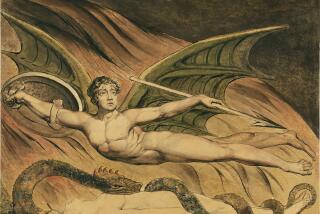William Blake: A Creator, Not a Mystic
- Share via
In an otherwise fine review of the Huntington Library and Art Gallery’s current William Blake exhibition, Times art critic William Wilson resurrects the terrible groaner of pegging the man as a “mystic” and a “metaphysical seer” (“William Blake’s Vision Shines in His Prints at Huntington,” Oct. 4).
Led by Northrop Frye, Blake scholars have spent the better part of 40 years patiently pleading with various Victorian graveyard poets, alchemists, Druids, beats, hippies and New Agers to stop reading Blake as a mystic. Blake remains misunderstood largely because of the “mystic-seer” label that distorts his ideas.
Blake hated mystery and transcendence because they hint at illusory things beyond the human. The imaginative act is the only reality in Blake. He didn’t buy into the spirit world, nor did he believe that the Bible and physics had any objective existence apart from their imaginative constitution.
Long before Einstein, Blake’s art argued that Newton’s clockwork universe, unbending time and even atoms were illusory. Blake never saw the artist as a mystifier. Indeed, he saw certain theories becoming a mystified “priesthood” and became furious when artists worshiped them. Blake is not Wilson’s “seer”; he is a creator, defending a human perspective.
BRAD ZUKOVIC
Hollywood
More to Read
The biggest entertainment stories
Get our big stories about Hollywood, film, television, music, arts, culture and more right in your inbox as soon as they publish.
You may occasionally receive promotional content from the Los Angeles Times.









